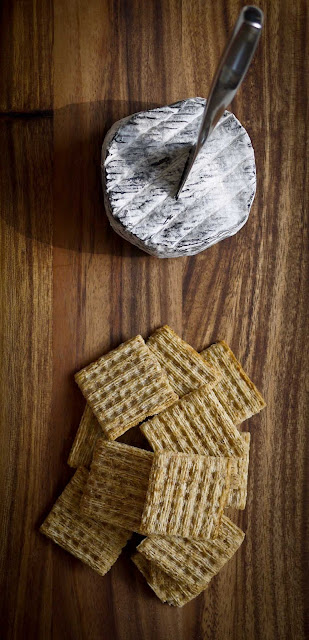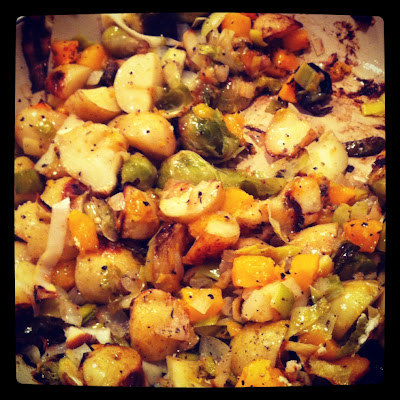The 'tres leches' (err, 'tre latti' in its native language) of Italian cheeses, this superbly creamy cheese is made up of goat, sheep, and cow's milk. A tiny bit pungent but smooth enough to be a definite crowd pleaser - the bonus is a beautiful and delicious rind made of vegetable charcoal.
I first tried this a few weeks ago at a favorite Monday night destination, the Larder Wine & Cheese Club at Tavern (the birthplace of this blog - click here for a refresher). It was my favorite cheese of the night so I had to take some home.
Here it is, served this past weekend with a bit of raw honey and... Triscuits (it's all I had!):
Thursday, June 21, 2012
Mount Mazama
Tonight's dinner was the first 'garden-to-plate' of the year. A simple arugula salad with basil & chives, dressed with olive oil, sea salt and a freshly squeezed key lime.
The highlight was a last minute addition of a new cheese to me, Mount Mazama. Mount Mazama is a goat's/cow's milk blend cheddar hailing from Central Point, Oregon creamery Rogue. It's not too sharp (though in my book there is no such thing as 'too sharp'), with a nice, smooth flavor and a tangy after taste, moist but still flaky. I hear it's fantastic in a mac n' cheese, so perhaps I've found my next kitchen adventure...
The highlight was a last minute addition of a new cheese to me, Mount Mazama. Mount Mazama is a goat's/cow's milk blend cheddar hailing from Central Point, Oregon creamery Rogue. It's not too sharp (though in my book there is no such thing as 'too sharp'), with a nice, smooth flavor and a tangy after taste, moist but still flaky. I hear it's fantastic in a mac n' cheese, so perhaps I've found my next kitchen adventure...
Monday, June 11, 2012
Heywood Grilled Cheese Shoppe
I think I gained 10 lbs after only reading this article. A GOURMET GRILLED CHEESE SHOP has just opened in my neighborhood. !!!
Words cannot describe the excitement...
http://la.eater.com/archives/2012/06/04/heywood_grilled_cheese_shoppe_getting_gooey_with_it_in_silver_lake.php
Words cannot describe the excitement...
http://la.eater.com/archives/2012/06/04/heywood_grilled_cheese_shoppe_getting_gooey_with_it_in_silver_lake.php
Wednesday, June 06, 2012
Rewind
It was a barren winter and spring on this blog, but I actually did have a number of things to share during my silence.
They'll trickle in as I put them together; This one is from February.
How great is my now-husband at Valentine's Day?
Ingredients:
They'll trickle in as I put them together; This one is from February.
How great is my now-husband at Valentine's Day?
Saint Agur Blue, Double Creme Brie, Demetria Pantheon
Thomas Keller's Roast Chicken and Root Vegetables Recipe
The chicken must be at room temperature before it goes in the oven, or the chicken will not cook evenly. What Keller recommends is leave the chicken in the refrigerator, uncovered (on a plate and not touching anything else in the fridge), for 1-2 days after buying it, so that the skin gets a bit dried out. It will roast up crispier this way. Then 1 1/2 to 2 hours before it goes in the oven, we put it on a plate on the kitchen counter to come to room temp (about 70 degrees). Remove the neck and giblets from the cavity of the chicken before you set it out to come to room temp.
-One 4 to 4
1/2 pound chicken
-Kosher
salt and freshly ground black pepper
-6
garlic cloves, smashed and peeled (smash with the side of a chef's knife, makes
it easier to peel)
-6
thyme sprigs
-3
medium-sized rutabagas, ends cut and
discarded, rutabagas peeled, and any outer tough layer discarded, then
rutabagas cut into 3/4-inch wedges
-2
medium-sized turnips, prepared the same way as the rutabagas
-4
medium-sized carrots, peeled and cut in 2-inch segments
-1
small yellow onion, peeled, roots cut off but core kept intact, other end cut off and
discarded, the onion then cut into quarters
-8
small red-skinned new potatoes
-About
1/3 cup olive oil or grapeseed oil (Keller uses canola oil, you can just use olive oil)
-4
Tbsp butter, room temperature
-A
large cast-iron frying pan
-Kitchen
string
1 Preheat oven to 475°F.
2 Use a paring knife to cut away the wishbone from the neck/breast area of the chicken. You will probably have to use your fingers to feel around for it. This is a little bit tricky, but if you can remove the wishbone first, it will make the chicken easier to carve after it is cooked. (This ease of future carving is the only reason to take the bone out, so you can leave it in if you want.)
3 Generously season the cavity of the chicken with salt and pepper. Add three of the garlic cloves and 5 sprigs of the thyme to the cavity, using your hands to rub the thyme and garlic all around the cavity.
4 Truss the chicken with kitchen string. To do so, start by cutting a 3-foot section of cotton kitchen string. Place the chicken so that it is breast up, and the legs pointing toward you. Tuck the wing tips under the chicken. Wrap the string under the neck end of the bird, pulling the string ends up over the breast, toward you, plumping up the breast. Then cross the string under the breast (above the cavity and between the legs). Wrap each end around the closest leg end, and tie tightly so that the legs come together.
5 Place the vegetables, onions, garlic, and remaining thyme sprig into a bowl. Add 1/4 cup of olive oil (or grapeseed, olive or canola oil) and toss with your hands until well coated. Season generously with salt and pepper.
6 Slather the chicken with oil and season well with salt and pepper.
7 Create a bed of the root vegetables in a large cast iron pan (or use a regular roasting pan if you don't have a cast iron pan.) Place the chicken on the bed of vegetables. Slather the top of the chicken breasts with butter.
8 Place the pan in the oven and roast the chicken for 25 minutes at 475°F. Then reduce the heat to 400°F and roast for an additional 45 minutes, or until the thickest part of the thigh registers 160°F on a meat thermometer and the juices run clear.
9 Transfer the chicken to a cutting board, cover with aluminum foil and let rest for 20 minutes before carving to serve. You can keep the vegetables warm by keeping them in the now-turned-off oven while the chicken is resting. Stir to coat the vegetables with the cooking juices before serving
10 Cut the chicken into serving pieces. Place vegetables on a serving platter with the chicken pieces arranged on top.
Serves 4.
Matt found this video helpful during his prep:
Tuesday, June 05, 2012
A Necessary Purchase
Could you spend $10 on something better? Yes. But there's something about the feeling of self satisfaction when correctly labeling all of the cheeses (in my case Stilton, Manchego, and Port Salut) in your presentation.
I got these dry-erase cheese markers (set of 6) from Crate and Barrel, and they certainly are awesome do the job.
Photographed at our kickoff to summer BBQ this weekend:
Friday, June 01, 2012
Subscribe to:
Comments (Atom)




















